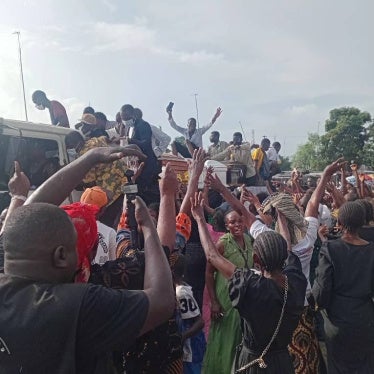Drawings by children from Darfur depict harrowing human rights violations against civilians in the western province of Sudan, Human Rights Watch said today.
Human Rights Watch today released an online gallery of Sudanese children’s drawings that illustrate the war in Darfur through children’s eyes. The drawings show bombings by Sudanese government forces, attacks by Khartoum-backed “Janjaweed” militias, shootings, rapes, the burning of entire villages, and the refugees’ flight to Chad.
“These astonishing drawings by children fully corroborate the atrocities we have been documenting in Darfur over the past year,” said Olivier Bercault, a Human Rights Watch researcher who has traveled in Sudan and Chad to document the conflict. "Thanks to the children, we now have these graphic representations of the crimes they and their families witnessed."
In February 2005, Human Rights Watch researchers Dr. Annie Sparrow and Olivier Bercault visited Chad to speak with refugees who had fled the killing campaign in Darfur. As a pediatrician, Dr. Sparrow was accustomed to providing children with crayons and paper to draw while she spoke with their parents. Without any instruction or prompting, dozens of children produced disturbing and vivid images of the atrocities they had witnessed.
Schoolchildren from seven refugee camps and the border town of Tine, Chad, offered Human Rights Watch’s researchers hundreds of drawings in the hope that the rest of the world would see their stories as described in their own unique visual vocabulary of war.
Magda [names changed for children’s protection], age 9, describes her drawing, “We were running from the burning houses. Janjaweed and soldiers with guns and planes and bombs came, all together, quickly. They were shooting…. My uncle was shot. I saw them taking women and girls away.”
Human Rights Watch said that the government of Sudan is responsible for “ethnic cleansing” and crimes against humanity in Darfur, one of the world’s poorest and most inaccessible regions. Government forces oversaw and directly participated in massacres, summary executions of civilians—including women and children—burnings of towns and villages, and the forcible depopulation of wide swathes of land long inhabited by the Fur, Masalit, Zaghawa, and other ethnic groups.
Countless women and girls have been raped. Hundreds of villages have been bombed and burned; water sources and food stocks have been destroyed, property and livestock looted. Mosques, schools and hospitals have been burnt to the ground.
The United Nations estimates that more than 2 million people have been left homeless in the fighting. There are as many as a quarter of a million refugees in neighboring Chad, one of the poorest countries in Africa. Estimates of mortality in Darfur vary widely. It is likely that at least 100,000 people have died from violence, disease and other conditions related to forced displacement and insufficient access to humanitarian assistance. The toll of death and displacement continues to rise.








